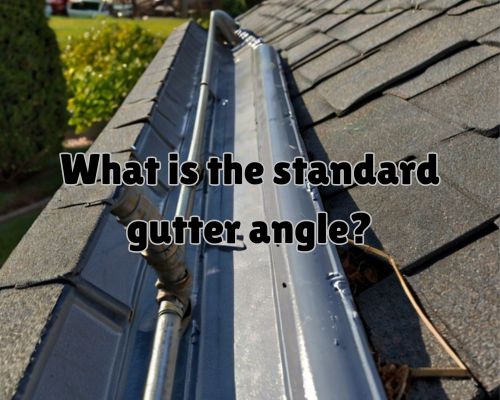When it comes to maintaining your home, gutters are an essential component to keep in good condition. They help direct water flow away from your roof and foundation, preventing damage and costly repairs.
One important aspect to consider when installing or repairing gutters is the angle or slope of the gutter.

The standard gutter angle is typically a 1/4 inch slope for every 10 feet of gutter. This means that for a 40-foot gutter run, the gutter should be sloped down 1 inch from one end to the other to ensure proper water flow.
However, the exact angle may vary depending on the specific needs of your home and climate.
Proper gutter slope is crucial for ensuring that water flows freely through the gutter system and away from your home. Without proper slope, water can pool in the gutters, leading to damage to the gutter system, roof, and potentially the foundation of your home.
It’s important to have a professional assess your gutter slope to ensure that it’s at the appropriate angle for your specific home and location, see Gutter Cleaning near me.
Understanding Gutter Slope
Fundamentals of Gutter Slope
Gutter slope refers to the angle at which gutters are installed to ensure proper water drainage. The slope is also known as pitch and is measured in inches of vertical drop over a horizontal distance of 12 inches.
The correct gutter slope is essential for directing water towards the downspouts and preventing water damage to your home’s foundation, walls, and landscaping.
To determine the correct gutter slope, you will need a level, chalk line, tape measure, and calculator.
The gutter should be installed level along the roofline, but it should slope downward towards the downspout to ensure proper water flow. The minimum slope recommended by professionals is 1/4 inch per 10 feet of gutter.
Calculating the Correct Gutter Slope
To calculate the correct gutter slope, you will need to measure the length of the gutter along the roofline, from the high point to where it meets the downspout.
For every 10 feet of gutter, you should allow a 1/4 inch drop. Multiply the length of the gutter (in feet) by 1/4 inch to find the total slope needed. Use a chalk line to mark the slope on the gutter and ensure that it is straight.
Alternatively, you can use the 1/4 inch rule to determine the correct gutter slope. According to this rule, the gutter should slope down 3/4 inch from one end to the other (1/4 inch x 3 = 3/4 inch). If the gutter starts at 0 inches, it should end at 3/4 inch lower to ensure proper slope.
Importance of Proper Slope for Water Drainage
Proper gutter slope is essential for effective water drainage and preventing water damage to your home. Without the correct slope, water can accumulate in the gutters, overflow, and cause damage to your home’s foundation, walls, and landscaping.
Additionally, stagnant water in the gutters can attract pests and promote the growth of mold and mildew.
Gutter Installation and Maintenance
Step-by-Step Guide to Gutter Installation
Installing gutters can be a DIY project, but it’s important to have some knowledge about the process before starting.
First, determine the length of gutter needed by measuring the roofline. Next, choose high-quality materials and hangers that can support the weight of the gutter.
Proper installation techniques are crucial for efficient water flow and adequate drainage.
If you’re not comfortable with DIY, it’s best to seek professional help. Professional gutter installers (see Gutter Cleaning near me) have the experience and workmanship to ensure seamless gutter installation. They can also adjust gutter slope and downspout placement for optimal performance.
Common Mistakes and Troubleshooting
One of the most common mistakes homeowners make is installing gutters with an incorrect slope. This can lead to water pooling and damage to the gutter system. To avoid this, calculate the correct pitch angle and adjust the slope accordingly.
Another common issue is gutter repair. Regular maintenance can prevent the need for costly repairs. Check for leaks, clogs, and damage to the gutter hangers. If you notice any issues, address them promptly to avoid further damage.
Regular Maintenance for Longevity
Home maintenance is crucial for the longevity of your gutter system.
Regularly clean out debris and leaves to prevent clogs. Adjust gutter slope if necessary to ensure proper water flow.
Check for damage to the gutter hangers and repair as needed.
In summary, proper gutter installation and maintenance are essential for efficient water flow and adequate drainage.
Whether you choose to DIY or seek professional help, use high-quality materials and installation techniques.
Regular maintenance can prevent common issues and prolong the life of your gutter system.